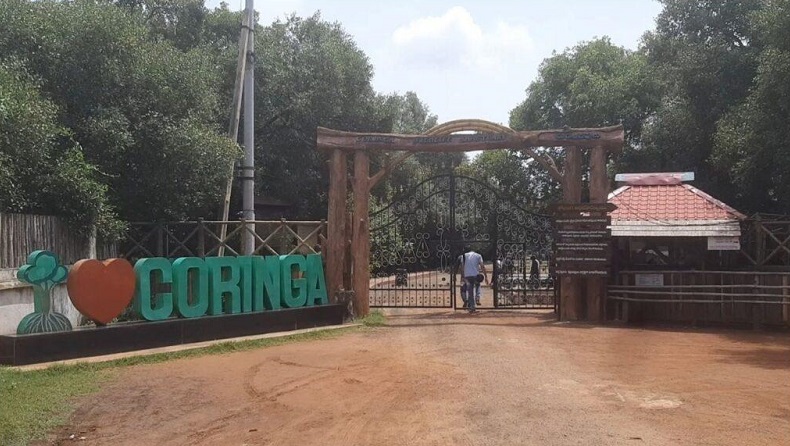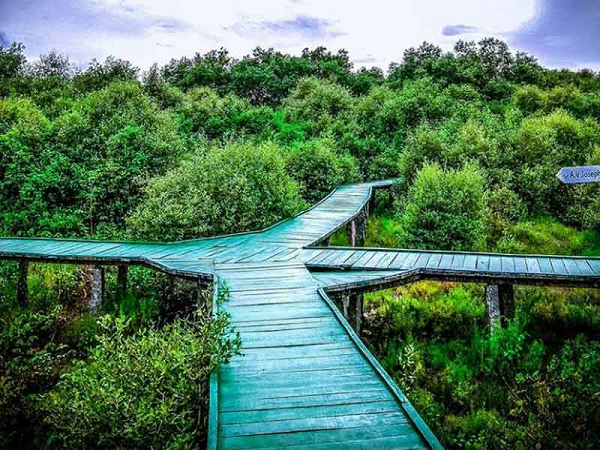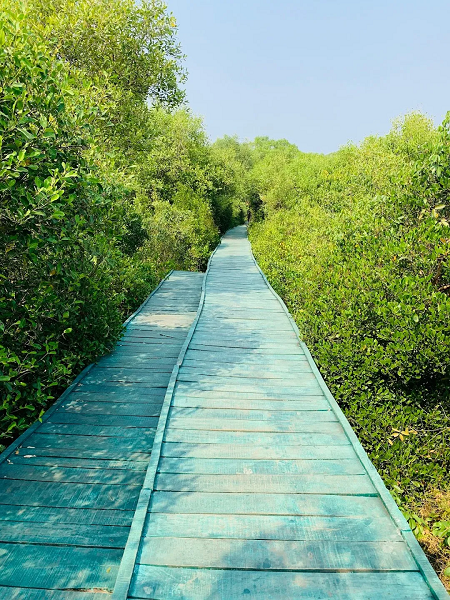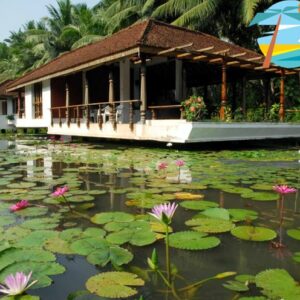Nestled along the serene coastline of Andhra Pradesh, Coringa Wildlife Sanctuary stands as a sanctuary of biodiversity, offering a glimpse into the rich ecosystems of India’s eastern coast. Spread across the Godavari delta region near Kakinada; this sanctuary spans approximately 235 square kilometres, encompassing a unique blend of mangrove forests, estuaries, and backwaters. Established in 1978, Coringa Wildlife Sanctuary was declared as a sanctuary primarily to conserve the critically endangered white-backed vulture, but it has since evolved into a haven for various species of flora and fauna.
Overview and Significance of Coringa Wildlife Sanctuary:
Coringa Wildlife Sanctuary is renowned for its mangrove ecosystem, which plays a crucial role in maintaining ecological balance and protecting coastal areas from erosion and natural calamities. The sanctuary is home to a diverse array of wildlife, including fishing cats, otters, estuarine crocodiles, and several species of birds such as the endangered white ibis and the grey pelican. Additionally, the mangrove forests harbour a wide variety of plant species, with their intricate root systems providing vital nurseries for numerous marine organisms.
Timings:
- The sanctuary is open to visitors from 8:00 AM to 5:00 PM, allowing ample time to explore its natural wonders and observe the diverse wildlife that inhabits its tranquil surroundings.
Entry Ticket Price:
- The Coringa Wildlife Sanctuary entry fee is Rs, 10 for adults and Rs. 5 for kids.
Best Time To Visit:
- The ideal time to visit Coringa Wildlife Sanctuary is during the winter months, from November to February, when the weather is pleasant, and the migratory bird populations are at their peak. During this time, visitors can witness the sanctuary teeming with activity as numerous bird species flock to the area, making it a paradise for birdwatchers and nature enthusiasts.
How To Reach:
- Coringa Wildlife Sanctuary is located approximately 20 kilometres from Kakinada, a major city in Andhra Pradesh. The sanctuary is easily accessible by road, with regular bus services and private taxis available from Kakinada. The nearest railway station is Kakinada Junction, which is well-connected to major cities across India. Additionally, Rajahmundry Airport, located around 70 kilometres away, serves as the nearest airport for those travelling by air.
Things To Do:
- Bird Watching: Explore the sanctuary’s numerous trails and birdwatching points to observe a wide variety of avian species in their natural habitat. Look for migratory birds such as flamingos, herons, and spoonbills, which visit the sanctuary during the winter months.
- Boat Safari: Embark on a serene boat safari through the sanctuary’s meandering waterways. This offers a unique perspective of the mangrove forests and the diverse wildlife that thrives within them. Experienced guides accompany visitors, providing insights into the sanctuary’s ecology and wildlife.
- Nature Walks: Take leisurely strolls along the sanctuary’s well-marked trails, immersing yourself in the tranquil ambience of the mangrove forests and observing the myriad plant and animal species that call this sanctuary home.
Coringa Wildlife Sanctuary – Nearby Tourist Attractions:
- Hope Island: Situated off the coast of Kakinada, Hope Island is renowned for its pristine beaches and tranquil ambience. It offers opportunities for relaxation and water sports activities such as swimming and boating.
- Uppada Beach: Located just a short distance from Coringa Wildlife Sanctuary, Uppada Beach is a popular tourist destination known for its picturesque coastline and vibrant local culture. Visitors can enjoy activities such as beachcombing, kite flying, and sampling local delicacies at the nearby seafood shacks.
- Papi Kondalu: Embark on a scenic boat cruise along the majestic Papi Kondalu (Papikondalu) Gorge, located on the Godavari River. This gorge offers breathtaking views of lush green hills, cascading waterfalls, and tribal hamlets nestled along the riverbanks.
- Yanam Beach: Relax and unwind at Yanam Beach, where golden sands meet the azure waters of the Bay of Bengal. This beach offers a perfect setting for picnics, leisurely walks, and sunset views.
- Draksharamam: Draksharamam is home to one of the five powerful Pancharama Kshetras dedicated to Lord Shiva, known as the Draksharama Temple. This ancient temple believed to have been built during the 9th century, stands as a testimony to the region’s rich cultural heritage and architectural prowess.
- Annavaram: The Annavaram Temple is dedicated to Lord Veera Venkata Satyanarayana Swamy, an incarnation of Lord Vishnu. Devotees visit the temple to offer prayers and seek Lord Satyanarayana’s blessings for prosperity, health, and happiness in their lives.
- Dindi: Dindi, a charming village nestled along the tranquil backwaters of the Godavari River in Andhra Pradesh, India, offers a serene and picturesque getaway for travellers seeking a break from the hustle and bustle of city life. Known for its natural beauty, serene ambience, and traditional charm, Dindi is a popular destination for nature lovers, adventure enthusiasts, and those looking to experience the authentic rural life of coastal Andhra Pradesh.
- Kodandarama Temple, Gollala Mamidada: The Kodandarama Temple in Gollala Mamidada is renowned for its unique architectural feature, “Bimba Pratibimba Vilakshanam,” which translates to “Mirror Image Effect.” This architectural phenomenon is a significant aspect of the temple’s design and holds special religious and cultural significance.
Coringa Wildlife Sanctuary Tips To Follow:
Visiting the Coringa Wildlife Sanctuary offers a chance to immerse yourself in the beauty of nature and witness the diverse flora and fauna of the mangrove ecosystem. To make the most of your visit, here are some helpful tips:
- Plan Your Visit in Advance: Before planning your trip, check the sanctuary’s opening hours, entry fees (if any), and seasonal timings. It’s also advisable to inquire about any specific regulations or guidelines that visitors need to follow.
- Choose the Right Season: The best time to visit the sanctuary is during the winter months (November to February) when the weather is pleasant, and migratory birds flock to the region. Avoid visiting during the monsoon season (June to September) when heavy rainfall and high water levels may restrict access to certain areas of the sanctuary.
- Wear Appropriate Clothing: Dress comfortably and wear lightweight, breathable clothing suitable for the tropical climate. Don’t forget to apply sunscreen, wear a hat, and bring along insect repellent to protect yourself from the sun and mosquitoes.
- Stay Hydrated: Carry an adequate supply of water to stay hydrated, especially if you plan on exploring the sanctuary on foot or spending an extended period outdoors.
- Pack Essentials: If you’re planning a day trip, bring along essentials such as a camera or binoculars for wildlife viewing and photography, as well as snacks or light refreshments. Remember to carry a small backpack or bag to store your belongings.
- Follow Safety Precautions: Respect wildlife and maintain a safe distance from animals to avoid disturbing their natural behaviour. Stay on designated trails and follow instructions provided by guides or sanctuary staff to ensure your safety and the protection of the environment.
- Engage a Guide: Consider hiring a knowledgeable guide or joining a guided tour to learn more about the sanctuary’s ecology, wildlife, and conservation efforts. Guides can enhance your experience by providing insights and identifying wildlife species during your visit.
- Practice Responsible Tourism: Help preserve the sanctuary’s natural beauty and biodiversity by minimizing your impact on the environment. Avoid littering, stay on designated paths, and refrain from feeding or disturbing wildlife.
- Be Patient and Observant: Wildlife sightings can be unpredictable, so be patient and observant during your visit. Keep your eyes peeled for birds, reptiles, and other wildlife hiding among the mangroves, and enjoy the serenity of the sanctuary’s tranquil surroundings.
- Capture Memories Respectfully: Take photographs and memories of your visit, but do so respectfully and without causing disturbance to wildlife or other visitors. Remember to leave only footprints and take only memories, leaving the sanctuary as pristine as you found it.
By following these tips, you can have a rewarding and memorable experience exploring the Coringa Wildlife Sanctuary while respecting the sanctuary’s natural environment and inhabitants.
In conclusion, Coringa Wildlife Sanctuary offers a captivating glimpse into nature’s wonders, with its pristine mangrove forests, diverse wildlife, and serene waterways. Whether you’re a nature enthusiast, a birdwatcher, or simply seeking solace amidst the tranquillity of the natural world, a visit to this sanctuary promises to be a memorable experience filled with exploration and discovery.
Akshata Singh
Akshata Singh is a senior content writer with experience of 6 years. She has been writing articles for lifestyle blogs, i.e., Health, Beauty, Fashion, Interior, Products & many more. To know more about her works, do check out the below profiles.





